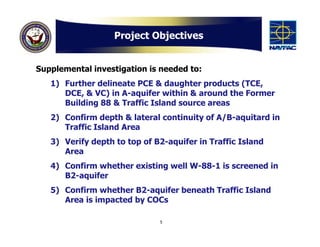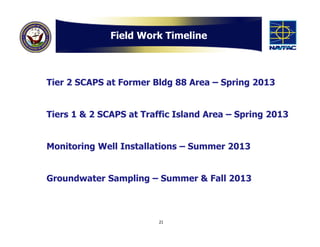Site 28 Supplemental Investigation
- 1. Former NAS Moffett Field Site 28 Supplemental Investigation Neil Hey, PG Shaw E & I, Inc. & Valerie Harris, PE Remedial Project Manager Navy BRAC PMO West RAB Meeting February 7, 2013
- 2. Presentation Overview Project Objectives Technical Approach Preliminary Results Remaining Work Questions 2
- 3. 3
- 5. Project Objectives Supplemental investigation is needed to: 1) Further delineate PCE & daughter products (TCE, DCE, & VC) in A-aquifer within & around the Former Building 88 & Traffic Island source areas 2) Confirm depth & lateral continuity of A/B-aquitard in Traffic Island Area 3) Verify depth to top of B2-aquifer in Traffic Island Area 4) Confirm whether existing well W-88-1 is screened in B2-aquifer 5) Confirm whether B2-aquifer beneath Traffic Island Area is impacted by COCs 5
- 6. Technical Approach Phase 1 – Semi-quantitative Screening Survey To further assess the distribution of CEs and soil lithology in the areas of interest Phase 2 – Monitoring Well Installations & Sampling To fill in data gaps of the current groundwater monitoring well network 6
- 7. Navy SCAPS Rig 7
- 8. SCAPS Probe From: U.S. Army Corps of Engineers, 2002, Cost and Performance Report for Tri-Service SCAPS MIP, January , ERDC/EL TR-02-1 8
- 9. MIP/DSITMS System Membrane interface probe (MIP)/ Direct sample ion-trap mass spectrometer (DSITMS) detector System Semi-quantitative COC concentration data (mg/L of calibration solution) MIP data are only considered estimates (USACE, 2002) <http://el.erdc.usace.army.mil/elpubs/pdf/trel02-1.pdf> Results by MIP system are relative & should be verified by soil and groundwater samples (EPA, 2012) <http://www.clu-in.org/characterization/technologies/mip.cfm> 9
- 10. SCAPS Test Results – Former Bldg 88 General Tier 1 SCAPS test location Groundwater Flow Direction Tier 2 SCAPS test location µg/Lcs denotes micrograms per liter of DSITMS calibration solution 11.1 ft bgs 210,000 µg/Lcs – MIP 440 µg/L - GW Maximum MIP/DSITMS 11.5 ft bgs 0.45 mg/kg - Soil 830,000 µg/Lcs – MIP Response & Groundwater 660 µg/L - GW 8.8 mg/kg - Soil and Soil Results PCE 10 ~6 to 16 ft bgs (Fine-grained Sediment Interval)
- 11. SCAPS Test Results – Former Bldg 88 General Tier 1 SCAPS test location Groundwater Flow Direction Tier 2 SCAPS test location µg/Lcs denotes micrograms per liter of DSITMS calibration solution 18 ft bgs 50,000 µg/Lcs – MIP Maximum MIP/DSITMS 78 µg/L - GW 1.9 mg/kg - Soil Response & Groundwater and Soil Results PCE 11 ~16 to 27 ft bgs (Coarse-grained Sediment Interval)
- 12. SCAPS Test Results – Former Bldg 88 General Tier 1 SCAPS test location Groundwater Flow Direction Tier 2 SCAPS test location Maximum MIP/DSITMS Response & Groundwater and Soil Results PCE 12 ~27 to 40 ft bgs (Fine-grained Sediment Interval)
- 13. SCAPS Test Results – Former Bldg 88 General Tier 1 SCAPS test location Groundwater Flow Direction Tier 2 SCAPS test location Maximum MIP/DSITMS Response & Groundwater and Soil Results PCE 13 ~40 to 56 ft bgs (Coarse-grained Sediment Interval)
- 14. SCAPS Test Results – Former Bldg 88 General Tier 1 SCAPS test location Groundwater Flow Direction Tier 2 SCAPS test location Maximum MIP/DSITMS Response & Groundwater and Soil Results PCE ~56 to 70 ft bgs (Coarse & Fine-grained 14 Sediment)
- 15. Preliminary Findings 1) SCAPS results generally correlate well with historical data 2) MIP/DSITMS detections of PCE primarily in fine-grained sediments 3) Highest MIP/DSITMS detections of TCE & DCE primarily in fine- grained sediments 4) Vinyl chloride was not detected in any of the MIP/DSITMS samples 5) Fine-grained sediments acting as a continuing source of chemicals to the groundwater 6) MIP/DSITMS responses are over 10-times higher than collocated discrete depth groundwater sample results 7) Discrete depth groundwater results are 10-times lower than estimated effective solubility limits 8) Discrete depth soil results are over 10-times lower than estimated soil saturation concentrations 15
- 16. Potential Well Locations Former Bldg 88 Area General Groundwater Flow Direction New Monitoring Well 11.1 ft bgs 210,000 µg/Lcs – MIP 440 µg/L - GW 11.5 ft bgs 0.45 mg/kg - Soil 830,000 µg/Lcs – MIP 660 µg/L - GW 8.8 mg/kg - Soil 16
- 17. Planned SCAPS Locations Traffic Island Area General Groundwater Flow Direction 17 0 to 23 ft bgs
- 18. Planned SCAPS Locations Traffic Island Area General Groundwater Flow Direction 18 23 to 46 ft bgs
- 19. Planned SCAPS Locations Traffic Island Area General Groundwater Flow Direction 19 46 to 65 ft bgs
- 20. Planned Well Locations Traffic Island Area 20
- 21. Field Work Timeline Tier 2 SCAPS at Former Bldg 88 Area – Spring 2013 Tiers 1 & 2 SCAPS at Traffic Island Area – Spring 2013 Monitoring Well Installations – Summer 2013 Groundwater Sampling – Summer & Fall 2013 21
- 22. Questions? Point of Contact: Scott Anderson BRAC Environmental Coordinator (619) 532-0938 scott.d.anderson@navy.mil 22





















